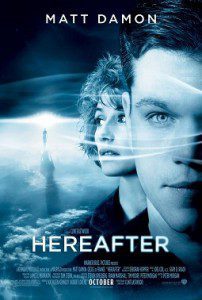 Hollywood has given us some very interesting versions of what may go on after death and how the living and the deceased interact. The recent film Hereafter, directed by Clint Eastwood and starring Matt Damon, explores patterns of connection between living people and those on the Other Side: the gift (or curse) of a natural psychic medium; a twin’s abiding link with the brother who died; the familiarity of a near-death survivor with other realms.
Hollywood has given us some very interesting versions of what may go on after death and how the living and the deceased interact. The recent film Hereafter, directed by Clint Eastwood and starring Matt Damon, explores patterns of connection between living people and those on the Other Side: the gift (or curse) of a natural psychic medium; a twin’s abiding link with the brother who died; the familiarity of a near-death survivor with other realms.
Home base, in Hereafter, is this world rather than the Other Side. Depictions of the afterlife that intrigue me most are those that take us deeper into Otherworld geography, especially those in which the Otherworld is home base. Here are notes on a few of my favorite Hollywood visions of the afterlife in classic movies, and conversation themes they suggest. .
- Dreaming is the best and easiest way to talk to the departed. The vital importance of dream communication with the departed is brought home by the movie The Sixth Sense. A psychic boy meets the Bruce Willis character, a man who had recently died but is foggy about his situation and distraught because he can no longer touch or talk to his wife. When he tries to speak to her she can’t hear him. The boy tells the dead guy how to proceed: “Speak to her in her dreams, only then will she hear you”.
- Why the departed stay earthbound or feel obliged to play tricks. The wonderful movie Ghost is quite instructive on how the Departed can stay earthbound through addictions and desires (witness the smoker on the subway, desperate for a last drag), and how and why the Departed may feel compelled to produce physical effects to get attention from survivors
– - The afterlife journey (like this one) is all about love and courage. The hilarious Albert Brooks comedy Defending Your Life gives a quite plausible version of a process of afterlife review and assessment, and makes the vital point that our courage – or lack of it – and our ability to love, and express that love, may be central to our progression in any world.
- In the reality we inhabit after death, thoughts are things. The movie What Dreams May Come dramatizes the fact that on the imaginal plane – which we enter in dreams and journeys, and where the Departed may find or build their homes, at least for a time – “thoughts are things”. This is a real world, but it is a world whose substance is ideoplastic; in other words, it will take on the shapes of our strongest thoughts and desires. To do well here, on either side of death, it is necessary to train the imagination
–
Movie stars can get to know a few things about the afterlife from sources other than movie scripts. According to Dan Aykroyd (the star of Ghostbusters), John Belushi reached out to living people after his death, desperate for help to get to a better life situation than the one he found himself in after he checked out through a dug overdose. Aykroyd said on the Larry King Show back in 2004 that a mutual friend called Isaac had a dream encounter in which Belushi asked for help in order to go into the Light. The reality of this contact seemed to be confirmed by the fact that Belushi used a personal name for his grandmother (“Nana”) that the dreamer did not recognize, but was known to Belushi’s widow. “So Isaac did a meditation with this woman that he worked with her inLos Angeles, and they had a vision of John, you know, extricating himself from bad circumstance, call it Limbo or the Bardo region, Purgatory. And they were able to cross him over into the light.”

